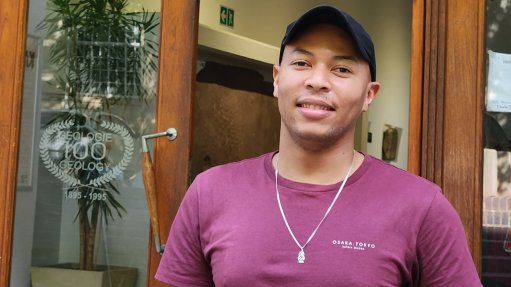
Stellenbosch University Department of Earth Sciences geometallurgy PhD student Steve Chingwaru
Stellenbosch University Department of Earth Sciences geometallurgy PhD student Steve Chingwaru has shown that, as historical mining of the Witwatersrand region focused almost uniquely on the free or native gold endowment, gold hosted in the sulphides has largely been overlooked and is deemed 'invisible’, as it is not recoverable by conventional methods.
Working with samples from tailing dumps in the Carletonville, Central Rand, Evander and Klerksdorp Goldfields, he used extensive in-situ laser ablation and acid digestion analyses to determine which minerals hosted most of the gold.
“We found that arsenian pyrite and pyrite accounted for 65% of gold in the Klerksdorp samples, 78% of the gold in the Carletonville samples and 85% of gold in the Evander samples,” he says.
Now that the team understands where the gold is located, as well as its concentration and mode of occurrence, the next step is to design and develop an effective leaching method to extract the gold, and valuable by-products, from the pyrite.
“By separating out these sulphide fractions during the reprocessing stage, it will also remove sulphide-associated heavy metals such as copper, cobalt and nickel. Not only are these economically valuable by-products, removal of sulphide minerals will also directly lessen the impact of acid mine drainage on the environment,” Chingwaru explains.
The mining of the Witwatersrand conglomerates, dating back to 1885, has resulted in the accumulation of six-billion tons of tailing materials. Owing to historical processing inefficiencies, these tailings are currently being remined as a secondary gold source.
“The objective is to optimise the use of natural resources while minimising environmental impact. Through my work, I strive to develop innovative methods to extract valuable metals from mine tailings and turn waste into a valuable resource,” he notes.
Chingwaru's research delves into the complex interplay between geological and metallurgical factors.
This intersection of paleo-geology and geometallurgy research contribution emanates from the new African Rainbow Minerals research chair in GeoMetallurgy, jointly held by Dr Bjorn von der Heyden from the Department of Earth Sciences and Dr Margreth Tadie from the Department of Process Engineering.
Both are Chingwaru’s study leaders and co-authors on the recently published article 'An underexploited invisible gold resource in the Archean sulphides of the Witwatersrand tailings dumps', published in the journal Nature Scientific Reports.